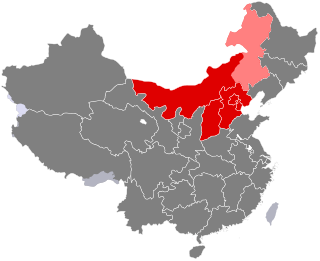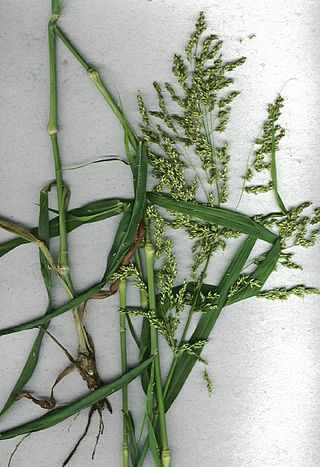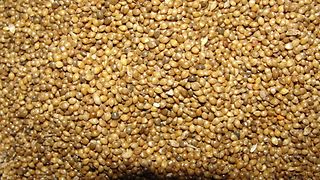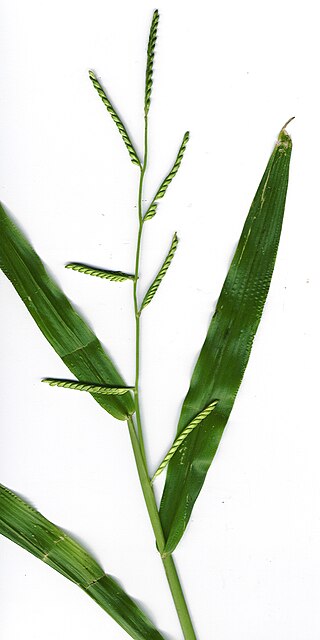
Millets are a highly varied group of small-seeded grasses, widely grown around the world as cereal crops or grains for fodder and human food. Most species generally referred to as millets belong to the tribe Paniceae.

Panicum miliaceum is a grain crop with many common names, including proso millet, broomcorn millet, common millet, hog millet, Kashfi millet, red millet, and white millet. Archaeobotanical evidence suggests millet was first domesticated about 10,000 BP in Northern China. Major cultivated areas include Northern China, Himachal Pradesh of India, Nepal, Russia, Ukraine, Belarus, the Middle East, Turkey, Romania, and the Great Plains states of the United States. About 500,000 acres are grown each year. The crop is notable both for its extremely short lifecycle, with some varieties producing grain only 60 days after planting, and its low water requirements, producing grain more efficiently per unit of moisture than any other grain species tested. The name "proso millet" comes from the pan-Slavic general and generic name for millet.

Panicum virgatum, commonly known as switchgrass, is a perennial warm season bunchgrass native to North America, where it occurs naturally from 55°N latitude in Canada southwards into the United States and Mexico. Switchgrass is one of the dominant species of the central North American tallgrass prairie and can be found in remnant prairies, in native grass pastures, and naturalized along roadsides. It is used primarily for soil conservation, forage production, game cover, as an ornamental grass, in phytoremediation projects, fiber, electricity, heat production, for biosequestration of atmospheric carbon dioxide, and more recently as a biomass crop for ethanol and butanol.

North China (华北) is a geographical region of China, consisting of two direct-administered municipalities, two provinces, and one autonomous region.

Panicum (panicgrass) is a large genus of about 450 species of Poaceae grasses native throughout the tropical regions of the world, with a few species extending into the northern temperate zone. They are often large, annual or perennial grasses, growing to 1–3 m (3–10 ft) tall.

Foxtail millet, scientific name Setaria italica, is an annual grass grown for human food. It is the second-most widely planted species of millet, and the most grown millet species in Asia. The oldest evidence of foxtail millet cultivation was found along the ancient course of the Yellow River in Cishan, China, carbon dated to be from around 8,000 years before present. Foxtail millet has also been grown in India since antiquity.

Echinochloa crus-galli is a type of wild grass originating from tropical Asia that was formerly classified as a type of panicum grass. It is commonly known as cockspur, barnyard millet, Japanese millet, water grass, common barnyard grass, or simply "barnyard grass". This plant can grow to 60" in height and has long, flat leaves which are often purplish at the base. Most stems are upright, but some will spread out over the ground. Stems are flattened at the base. The seed heads are a distinctive feature, often purplish, with large millet-like seeds in crowded spikelets.
Panicum mosaic virus (PMV) is a positive-sense single-stranded RNA viral pathogen that infects plant species in the panicoid tribe of the grass family, Poaceae. The pathogen was first identified in Kansas in 1953 and most commonly causes disease on select cultivars of turf grass, switchgrass, and millet. The disease most commonly associated with the panicum mosaic virus pathogen is St. Augustine Decline Syndrome, which infects species of turf grass and causes chlorotic mottling. In addition to St. Augustine Decline, panicum mosaic virus is responsible for chlorotic streaking and mild green mosaicking in select cultivars of switchgrass and millet.

Panicum antidotale Retz. is a tall, coarse, woody perennial grass throughout the Himalaya and the Upper Gangetic Plain and specifically in various regions of the Indian state of Punjab and the Pakistan province of Punjab and the neighbouring areas of these regions. The plant has strong spreading rhizomes.

The Termit Massif Total Reserve is a nature reserve in the southeast of Niger which was established in January 1962. In March 2012, a national nature and cultural reserve was established covering an area of 100,000 square kilometres (39,000 sq mi), including the entire area of the Termit Massif and Tin Toumma desert, making it the largest single protected area in Africa. The area provides habitat for many critically endangered species. Prominent among them is the addax antelope, which is categorized under the IUCN Red List as one of the rarest and most endangered species in the world; about 300 of them are reported in the reserve. A conservation effort has been launched by the Government of Niger in collaboration with many international conservation agencies. The reserve has also been declared an UNESCO World Heritage Site for the biodiversity value of the Termit Massif and surrounding Sahara Desert and for the cultural value of its archaeological sites.

Panicum turgidum is an old world clumping desert bunchgrass of the genus Panicum. It is a plant of arid regions across Africa and Asia, and has been introduced to other parts of the world.

Panicum sumatrense, known as little millet, is a species of millet in the family Poaceae.

Brachiaria, or signalgrass, is a genus of plants in the grass family native to tropical and subtropical regions of Asia, Africa, Australia, southern Europe, the Americas, and various islands. There are over 100 species.

Hymenachne is a genus of widespread wetlands plants that is in the grass family. They are commonly known as marsh grasses. They are distributed in tropical and subtropical regions of Asia, the Americas, and the Pacific Islands. A species from the Americas, H. amplexicaulis, is well known in other parts of the world as an introduced and invasive species.

Megathyrsus maximus, known as Guinea grass and green panic grass, is a large perennial bunch grass that is native to Africa and Yemen. It has been introduced in the tropics around the world. It has previously been called Urochloa maxima and Panicum maximum. It was moved to the genus Megathyrsus in 2003.

Panicum effusum, commonly known as hairy panic, is a grass native to inland Australia. It occurs in every mainland state, as well as New Guinea. In dry conditions, the fast-growing grass can become a tumbleweed.

Panicum repens is a species of grass known by many common names, including torpedo grass, creeping panic, panic rampant, couch panicum, wainaku grass, quack grass, dog-tooth grass, and bullet grass. Its exact native range is obscure. Sources suggest that the grass is native to "Africa and/or Asia", "Europe or Australia", "Eurasia", "Australia", "Europe, Asia, and Africa", or other specific regions, including the Mediterranean, Israel, and Argentina. It is present in many places as an introduced species and often a noxious weed. It has been called "one of the world's worst weeds."

Panicum coloratum is a species of grass known by the common names kleingrass, blue panicgrass (USA), white buffalograss ; Bambatsi panic, makarikari grass, and coolah grass (Australia). It is native to Africa, and it has been introduced elsewhere, such as the United States and Australia, and bred into many cultivars.

Panicum hillmanii, commonly known as Hillmann's panicgrass, is a grass from genus Panicum native to Southwestern United States. It has been introduced to many other areas, notably including southern Australia where it became widespread, and several parts of Europe.
















